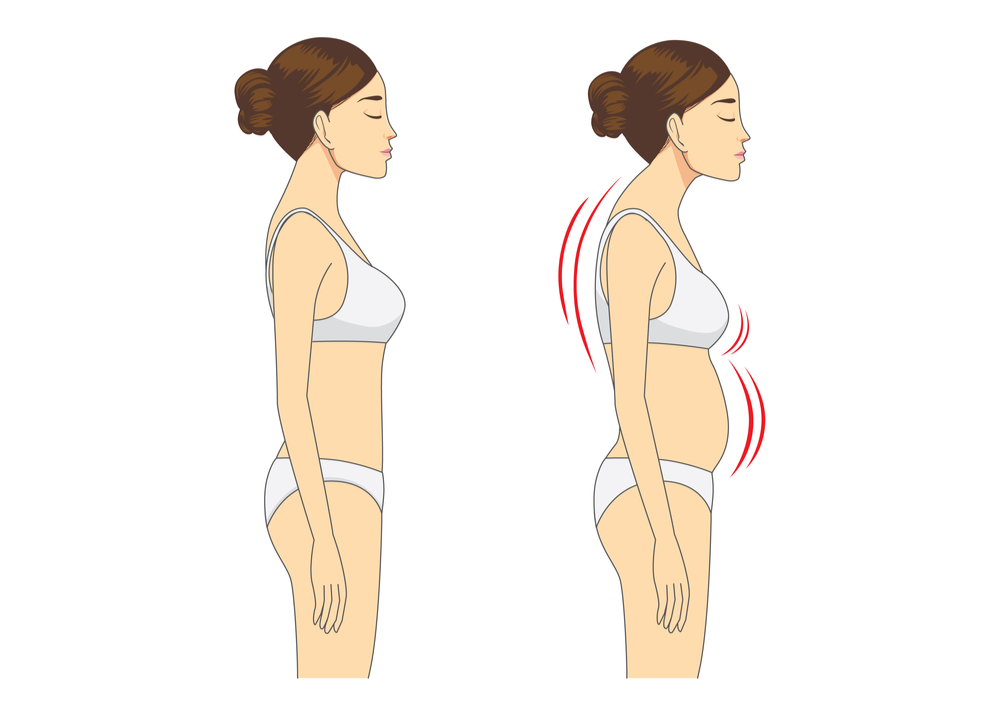The Health Effects of Poor Posture


Decent posture can make us look elegant, taller, and thinner – giving us an air of confidence. You may remember as a child being told to sit up straight. And if you have ever caught yourself slouching in the mirror, all hunched up, you may have quickly corrected your posture.
Correcting your posture is an important practice for your core. We should all try to pull ourselves out of bad posture habits because there are many health benefits, including reduced headaches, better digestion, and better breathing.
Your parents were correct, slouching and slumping positions are silly! (7)
Take A Stance
Posture is defined as the stance assumed by the body, either with support during muscular activity or as a result of a coordinated action performed by a group of muscles working to maintain stability.
It’s safe to argue that our spines engage posture more than any other part of our bodies. Depending on what you are doing, other muscles around the pelvis, legs, and buttock muscles can be involved. (2,4,5)
There are two kinds of posture;
- Dynamic posture refers to how we hold ourselves while moving, such as when walking, running, or picking up things. Dynamic posture is required to establish an efficient foundation for movement, and our muscles and non-contractile structures work naturally in order to adapt to changing conditions, during dynamic posture.
- Static posture refers to when our body’s segments are aligned and held in fixed positions – how we hold ourselves when we’re not moving, such as when sitting, standing, or lying in bed. This is typically accomplished through the coordination and interaction of various muscle groups that work statically to counteract gravity. (6)
As children, our movements are often easy and effortless. So if our bodies are designed to work in harmony, giving us everything we need to sit up straight and stand up tall, why do some of us end up with poor posture?
Hint —- we can’t blame gravity!
Imposters Of Good Posture
Bad posture is exacerbated by:
- Hunching up our shoulders or leaning forward while on the computer.
- Failing to take frequent breaks when we are using a computer.
- Spending too much time looking down at devices.
- Not getting enough physical activity.
- Sitting down for too long.
- Not stretching muscles after being in a stationary position.
- Wearing shoes that are stiff or restrictive, or wearing high heels.
- Stress. When we experience anxiety, our bodies respond with muscle tension.
- Obesity, bending the spine and joints.
- Accidents, injuries, and falls. (1,3)
Both overly tight, or weak muscles can also lead to poor posture. If you went to the gym seven days a week and did arduous leg exercises, your legs would be overworked and painful. Sitting at a desk all day can produce similar results causing muscles in your neck and back to exhaust. Your immune system’s efforts to heal those muscles cause inflammation, which can lead to arthritis in nearby joints. (9)
Weak muscles also cause poor posture. Unused muscles tend to tighten, and this muscle shortening can compact the bones of the spine (vertebrae) and worsen posture. (8)
Structural balance, referring to the human body is needed. This means having proportional strength and muscle balance in different areas of your body.
Skeletal muscle is made up of two types of muscle fiber – static (often called ‘slow twitch’) and phasic (often called ‘fast twitch’). The deeper layers of muscle are responsible for sensing our position in space and relaying this information to the brain. If this function is taken over by muscles that are primarily composed of phasic fibers (muscle fibers used for movement and activity), the brain receives an incomplete picture. (8)
Poor posture then causes muscle fatigue because it calls on these phasic fibers instead of our static fibers – (muscle fibers that help us maintain posture without effort and ‘sense’ our position) – to maintain the body’s position.
If the brain believes that the body needs to be propped up to counteract the effects of gravity, it causes additional muscle contraction. This adds to the fatigue and pain experienced by the person with poor posture. A more focused mind/body connection is needed. (8)
The Side-Effects Of Having Poor Posture
Bad posture can:
- Misalign your musculoskeletal system.
- Wear away at your spine, making it more fragile and prone to injury.
- Cause neck, shoulder, and back pain.
- Decrease your flexibility.
- Affect how well your joints move.
- Affect your balance and increase your risk of falling.
- Put pressure on the abdomen, making it harder to digest food.
- Cause chest muscles to tighten, making it harder to breathe. (6)
Poor circulation, bladder problems, jaw pain, fatigue, impaired lung function, even bad moods, and memory problems can also be long-term effects. (10,11)
Think you have what it takes to straighten yourself out and strengthen your posture? The good news is we all do.
Be In Charge Of Your Posture
There are many ways to help avoid and correct poor posture:
- Be mindful of posture during everyday activities, like watching television, washing dishes, or walking. As stated above, a good mind/ body connection is key.
- Stay active. Certain types of exercises can be helpful – yoga, tai chi, or classes that focus on body awareness. Do exercises that strengthen your core (muscles around your back, abdomen, and pelvis).
- Maintain a healthy weight.
- Wear low-heeled shoes. High heels can force you to walk differently, putting stress on your muscles.
- Make sure work surfaces are at a comfortable height.
- For tailored coaching, a back pain coach can help you build a strong posture. Look online to find experts who can help you from home. (12)
There are also different tips for standing and sitting:
Standing:
- Stand up straight and tall.
- Keep shoulders back.
- Pull your stomach in.
- Put weight mostly on the balls of your feet.
- Keep your head level.
- Let arms hang down naturally.
- Keep feet about shoulder-width apart.
Sitting:
- Switch sitting positions often.
- Take brief walks around your office or home.
- Gently stretch your muscles often to relieve muscle tension.
- Don’t cross your legs; keep your feet on the floor, with your ankles in front of your knees.
- Make sure that your feet touch the floor, or use a footrest.
- Relax your shoulders; they should not be rounded forward or pulled backward.
- Keep elbows close to your body, bent between 90 and 120 degrees.
- Make sure that your back is supported. Use a pillow or other back support if your chair does not have a backrest.
- Make sure that your thighs and hips are supported. You should have a well-padded seat, and your thighs and hips should be parallel to the floor. (12)
You can feel much better if you support your posture, therefore supporting your overall health and wellness. Good posture reinforces your equilibrium and improves stability, alignment, strength, and flexibility in your body.
And there’s a bonus. One day after you’ve been working on your posture for a while, you’ll happen to catch a glimpse of yourself in the mirror, and it will feel different. When this day comes, you just might be impressed by the more stately version of yourself, staring back.
- https://healthmatters.nyp.org/how-to-prevent-tech-neck/
- https://www.acatoday.org/Patients/Health-Wellness-Information/Posture
- https://www.uofmhealth.org/health-library/uz2225
- https://www.webmd.com/fitness-exercise/guide/better-posture-exercises
- https://www.healthline.com/health/guide-to-better-posture-exercises#first-week
- https://medlineplus.gov/guidetogoodposture.html
- https://www.dmc-healthcare.com/blog/10-benefits-of-good-posture
- https://www.betterhealth.vic.gov.au/health/conditionsandtreatments/posture
- https://health.clevelandclinic.org/health-effects-of-poor-posture/
- https://www.health.harvard.edu/staying-healthy/3-surprising-risks-of-poor-posture
- https://health.usnews.com/wellness/slideshows/10-ways-poor-posture-can-harm-your-health?slide=12
- https://medlineplus.gov/guidetogoodposture.html









